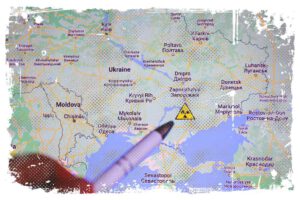Relations between Poland and Germany had been tensed for some time. Despite this, many Poles in August 1939 still believed that war would not happen. They tried to enjoy the summer, which was particularly nice that year. However, some were getting ready for what was to come on September 1st. Poles living in Gdansk or Sopot saw military equipment being transported through the streets at night, a sign that German paramilitary units were preparing for an attack.

August 23rd: The Day That Changed Everything
On Wednesday, August 23, 1939, the world was surprised to learn from Germany’s leading newspapers and radio stations that the Third Reich’s Foreign Minister, Joachim von Ribbentrop, had landed in Moscow. He flew on a special plane called “Grenzmark,” which had been given to him personally by Adolf Hitler.
At 3:30 p.m., Ribbentrop headed to a meeting with Joseph Stalin, head of the Communist Party, and Vyacheslav Molotov, chairman of the Council of People’s Commissars and People’s Commissar for Foreign Affairs of the USSR. The meeting lasted more than three hours and continued into the early hours of the next day, August 24. During this time, a non-aggression pact between the Third Reich and the USSR was agreed upon and immediately announced publicly. A secret additional protocol was also signed, which was never made public.
It dealt not only with Poland, but also with the possible behavior of England and France after the attack on Poland, as well as with the division into spheres of influence and interests – German and Soviet, across Europe. It was agreed that as events developed, there should be further consultations and decisions would be made once the two sides agreed.
↳ PRO TIP: Do you like traveling? Then before you buy any ticket or book an attraction, check if it's available in this worldwide Viator Database. You may save a lot of money and time. No need to thank me :)
Ribbentrop-Molotov Pact
Have you heard of the Ribbentrop-Molotov Pact? This was a secret agreement between Germany and the Soviet Union that was discovered by the Americans in the files of the German Foreign Ministry during the Nuremberg Trial in 1946. The Russians claimed it was fake, but it was actually written in both German and Russian and signed by Ribbentrop and Molotov in Moscow on August 23, 1939. It contained four points.
One of these points was about Poland. In the event that there were any changes to Poland’s territory, the pact stated that Germany and the Soviet Union would divide it up along the Narew, Vistula, and San rivers. It also mentioned that the possibility of a free state of Poland was left for later.
End of August 1939 in Gdansk
On August 23, a sudden coup d’état took place in the Free City of Danzig (Gdanska). The head of the Nazi party’s district, Albert Forster, declared himself head of state, which was not allowed by the city’s constitution. The League of Nations, which was supposed to protect the Danzig system, did not take any action. Its representative in Danzig, a Swiss diplomat, only declined an invitation to a reception given by Forster to celebrate his new position.
On August 24, it was announced that the borders between the Free City and Poland had been closed, although this was not entirely accurate as passenger traffic between the two places continued as normal. Some Polish youths tried to leave the Gdansk area to join the Polish army.
On August 25, the old German battleship “Schleswig-Holstein” arrived in the port of New Port (Nowy Port). The ship had been designated as a training ship, but it had actually picked up ammunition and an assault team from the German navy on its way. The ship’s visit was supposedly to pay tribute to sailors who had died in 1914 and were buried in the Gdansk Garrison Cemetery.
On August 30, three of the most valuable ships of the Polish Navy were ordered to go to sea immediately. These ships, called “Blyskawica,” “Grom,” and “Burza,” sailed to Great Britain. This weakened the Polish fleet in the Gulf of Gdansk, but it also ensured that the Polish flag would continue to fly in the future, even though the country had lost its ports.
The Plan to Attack Poland Had Been Ready Since April
The Third Reich, or Nazi Germany, had a plan for war against Poland called “Fall Weiss” ready to go since April and May 1939. During this time, the German secret services were working on creating excuses for the war, and they were also organizing provocations and propaganda diversions. Examples of these provocations include the one in Gliwice on August 31, 1939, and another one in Bydgoszcz.
Gliwice Provocation
The details of the Gliwice operation, which was a part of Germany’s preparations for the war with Poland, were revealed after the war as part of the Nuremberg Trials. According to Alfred H. Naujocks, a participant in the operation and an officer in the SS and SD, a group of 450 SS members, including some from the Fechtschule in Bernau, left Bernau near Berlin on August 23. Their mission was to carry out a diversionary action in the German border area by pretending to be attacked at the Gliwice (Gleiwitz) radio station. This operation was organized by the heads of the Gestapo, SD, and SS.
On the day before the operation, Hitler had told senior military commanders at his headquarters in Berchtesgaden that he would find a propaganda reason for attacking Poland, regardless of whether it was true or not. This operation was one example of the steps Nazi Germany took to prepare for the war with Poland.
Major events in August 1939
Here are the major events that took place in August 1939.
August 15, 1939
Schulenburg gave Molotov a memorandum that described the shift in relations between Germany and the Soviet Union. The memorandum stated that there were no conflicts in the interests of the two countries. It listed the issues that could be resolved “to mutual satisfaction,” including the Baltic States and Poland. The memorandum also emphasized the shared hostility towards “the capitalist Western democracies.” It also suggested a visit to Moscow by the German Foreign Minister, Ribbentrop. This memorandum marked a significant change in the relationship between Germany and the Soviet Union.
August 17, 1939
Molotov responded positively to the German memorandum and suggested that they sign a non-aggression pact with a secret protocol that outlines “the interests of the contracting parties in these or other foreign policy issues.” The first step towards this pact would be the signing of a credit and trade agreement. This marked a significant development in the relationship between the two countries, as they moved towards a formal agreement.
August 19, 1939
The signing of the German-Soviet trade-credit agreement was announced. On the same day, Molotov gave Schulenburg a draft of the planned non-aggression pact with a secret protocol, and invited Ribbentrop to come to Moscow. This marked an important step in the negotiations between the two countries and the development of their relationship.
August 21, 1939
Negotiations between the military missions of Britain, France, and the Soviet Union, which had been taking place in Moscow since August 12, were suspended. The Soviet side demanded that Poland allow them to use part of its territory in potential operations against Germany. Poland refused, understanding that the main goal of the Soviet Union was to take over these territories. This resulted in significant development in the tensions between these countries.
August 22, 1939
On August 26, 1939, Adolf Hitler ordered his troops to attack Poland in accordance with “Fall Weiss” (“White Plan”). The attack was to be launched from East Prussia towards Działdowo and Mława, from Western Pomerania towards Chojnice and Czersk, from Lower Silesia towards Wieluń, Łódź, Klobuck, and Częstochowa, and from Upper Silesia towards Katowice and Pszczyna.
Hitler said, “The destruction of Poland is our first task. The goal must be not to reach some marked line, but to destroy the living opponent Be merciless… Be brutal. The law is on the side of the stronger. One must act with maximum severity […] war must be a war of destruction. […] I have placed SS Totenkopf units only in the east, giving them the order to relentlessly and mercilessly kill women and children of Polish descent and Polish speech, for only by this means can we gain the living space we need.” This statement reflects the extreme brutality and violence of the German attack on Poland.
(August 22, 1939, Obersalzberg, speech by A. Hitler at a briefing with senior army commanders on the attack on Poland, from the book, The Polish Case in the International Arena during World War II, Warsaw 1965, p. 33).
August 23, 1939
Joachim von Ribbentrop visited Moscow and signed the Molotov-Ribbentrop Pact in the presence of Joseph Stalin. This pact was a prelude to the partition of Poland and established the division of the Soviet and German spheres of influence through the territory of the Republic along the Narew, Vistula, and San rivers.
August 25, 1939
Polish ambassador Edward Raczynski and British diplomatic chief Lord Edward Halifax signed an alliance treaty in London.
August 26, 1939
When Hitler learned of the conclusion of the Polish-British alliance, he cancelled the order to attack Poland. There was a clash between the Polish Army and German saboteurs in the area of the Jablonkowska Pass and the border station Mosty in Zaolzie. Germany apologized for the incident.
August 29, 1939
The Polish authorities decided to mobilize their military forces, but then cancelled the mobilization under pressure from the West. This decision reflects the complex international relations and the political pressures at play in the lead-up to the war.
August 30, 1939
Poland announced the mobilization of its military forces again. Please read my other article and check how weak was Poland againg the invaders on the first day of the war. The “Peking” plan was put into action. The three Polish destroyers left Gdynia-Oksywie: ORP “Blyskawica”, ORP “Burza,” and ORP “Grom.” They arrived in Great Britain on September 1, 1939. The purpose of this operation was to save the best Polish warships from being destroyed in the Baltic Sea. This reflects the efforts of the Polish authorities to prepare for the imminent war and protect their military assets.
August 31, 1939
On the night of August 31st, Hitler issued an order to attack Poland at 4:45 a.m. the following day. The German media has been claiming that it was Poland that initiated the conflict by crossing the border into Germany and rejecting Hitler’s „peace” demands, which included the return of Danzig, plebiscites, and the use of the port of Gdynia in exchange for similar privileges in the port of Danzig.
Bibliography:
- https://tygodnikbydgoski.pl/historia/sierpien-1939-roku-zanim-nastapil-niemiecki-atak-na-polske-23-08-2019
- https://historykon.pl/w-nocy-z-25-na-26-sierpnia-1939-roku-doszlo-do-tzw-incydentu-jablonkowskiego/




